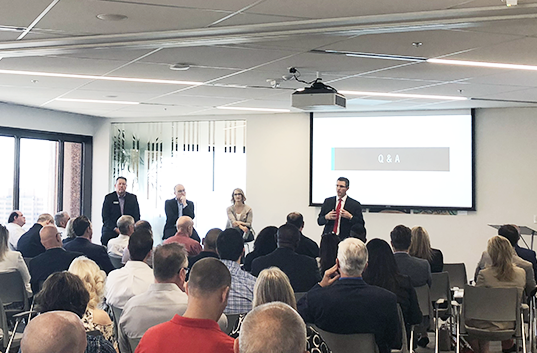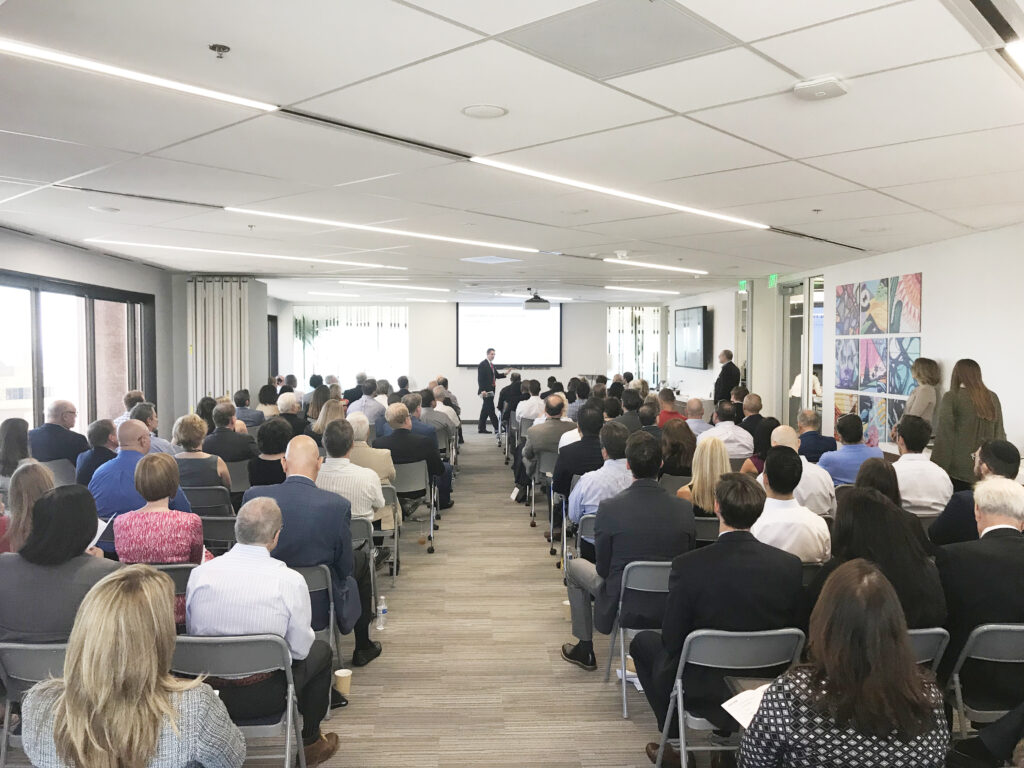

Greater Phoenix: A growth market with cyclical patterns
Published: 09/17/2018
Updated: 10/09/2019
A GPEC 101 Ambassador Event Recap
Greater Phoenix is a young region with a rich history.
Can you guess what the population was in 1950 in Greater Phoenix? 216,038 people. You read that right. Over the years, our region has grown tremendously from 216,038 to 4,737,270 in the last six decades. There are many pivotal moments in our history that helped define who we are today.
To learn more about the strategic vision for our region and the tactics that are being deployed to grow the Greater Phoenix economy, Greater Phoenix Economic Council (GPEC) held an Ambassador Event featuring GPEC president and CEO, Chris Camacho, and the leadership team.
Mayor Christian Price of the City of Maricopa kicked off the event with a brief overview of the Ambassador program, which provides networking and learning opportunities for employees of GPEC investors and member communities.
“What we’re trying to accomplish with this program is to bring networks together to make a greater impact,” Mayor Price said. “We want to talk positively about this region and about all the things we’re working towards. We can make that happen together.”
Greater Phoenix: Past
“What prompted people to leave places like Chicago and L.A.?” Chris Camacho asked. “What drove them to move here?”
Camacho took us back in time to the 1950s and introduced our regional transformation over the years through the Greater Phoenix timeline.
1950 – 1970s, A growing region:
From 1950-1970, the population of Greater Phoenix grew by 347%. The post-world war industry growth was driven by military base realignment and aerospace and defense company growth.The microelectronics cluster has been shaping the Greater Phoenix economy since 1949 when Motorola first opened a facility in the region. As Motorola invested in a variety of electronics manufacturing capabilities, Phoenix became a prime location for these activities.
1980, Intel expands to Chandler:
In 1980, Chandler city officials helped Intel secure permits that resulted in their further expansion in Greater Phoenix.
1989, Greater Phoenix Economic Council forms:
As a result of the momentum from the Barron’s article, GPEC was formed. Original GPEC Charter: A public purpose, non-profit organization, GPEC joined eight cities, the private sector, the region’s three major educational institutions and organized labor, in a collaborative effort to promote economic development for the region.
1990s, Greater Phoenix growth:
From 1990 to 2000 the population of Greater Phoenix grew by 46% and GDP grew by 103%. Throughout 1990s, a number of individual income tax cuts were made that led to significant revenue impacts to the state of Arizona.
2000s, Continued growth and crisis:
From 2000 to 2010, the population of Greater Phoenix grew by 29%. Major economic swings occurred during this decade as the market reeled from 9/11 attacks and global economic slowdown that followed. The World Bank said world trade was likely to grow by less than 2% in 2001, compared with 13% in the previous year.
2010s, Federal budget sequestration:
Defense contracts awarded in Arizona fell by $1.7 billion between 2012 and 2013, harmed by the federal budget sequestration, a drawdown of U.S. military commitments and a sluggish economy recovery. The GPEC Aerospace and Defense report showed that Greater Phoenix plays a major role in the national defense footprint with 5.2% of the state’s GDP being dependent on federal defense funding and Arizona ranked a top 10 state for defense contracts.
View the full timeline.
Greater Phoenix: Present
Branding
There has been a lot of opportunity to position Greater Phoenix so that we can better tell our story. In the last year, GPEC has secured over five billion media impressions.
“Out of market, when we tell people that we live here, you probably hear them say that it’s hot, we’ve got golf courses and retirement communities,” said Colleen Schwab, GPEC senior vice president of marketing and communications. “We want to change that narrative, and we’re doing that proactively through The Connected Place.”
Launched two years ago, The Connected Place celebrates emerging technologies. Because of this initiative, “We are now seeing fruits of that labor,” Schwab added. “Companies from other countries from across the globe are contacting us and are interested in coming here.”
Business Attraction
GPEC senior vice president of business development, Brad Smidt, provided insight on how the GPEC research, business development and marketing/communications teams work collectively to create business attraction.
In the last three years, GPEC has brought in 127 companies that located to the region, $3.04 billion in capital investment and 24,439 jobs created.
“Companies like Deloitte, ADP, Northern Trust, USAA and more have continued to see Greater Phoenix as a key place for them to expand.” Smidt said.
Competitiveness
From comparative analysis, economic development tools, high impact districts, intentional investment and market intelligence reports, there is a lot that goes on behind-the-scenes to bring the GPEC mission to life on a national and global scale.
“Our competitive analysis is an on-going process,” said Stephane Frijia, GPEC senior vice president of strategy and research. “As we spend time studying markets, we collect data and put them into use cases that are specific to industries like cybersecurity, software, aerospace, financial services and more.”
Greater Phoenix: Future
Camacho closed the presentation with a positive outlook on our region and discussed how the organization has embarked on a three-year strategic planning process so that we can take GPEC and the market to the next level.
“We have a solid market so far,” Camacho said. “We’re maturing as a market before our eyes and we have to be intentional and look at the fundamental dynamics of an economy and what drives economic performance.”
Let’s continue building the economy of Greater Phoenix.
Missed the event? Watch the Facebook Live footage here.
Are you interested in building a more vibrant economy in Greater Phoenix and helping to tell our region’s story? Become an Ambassador – learn more.
